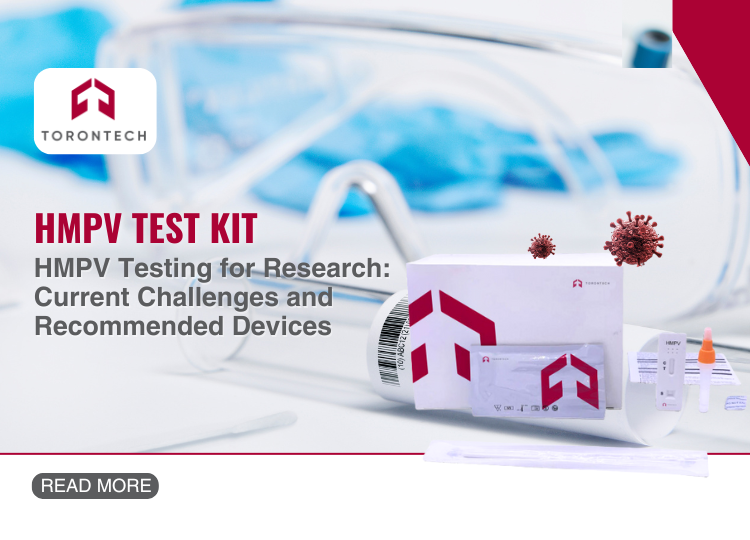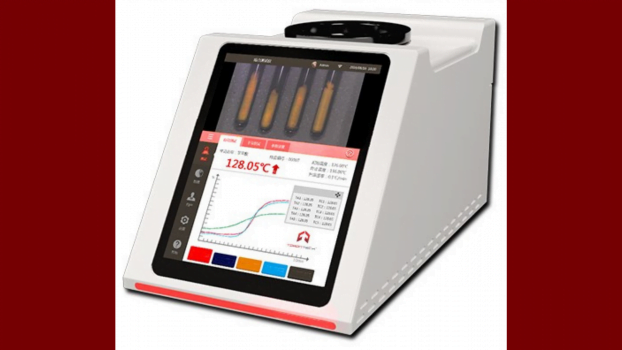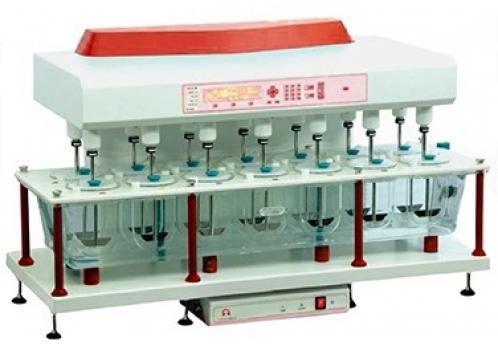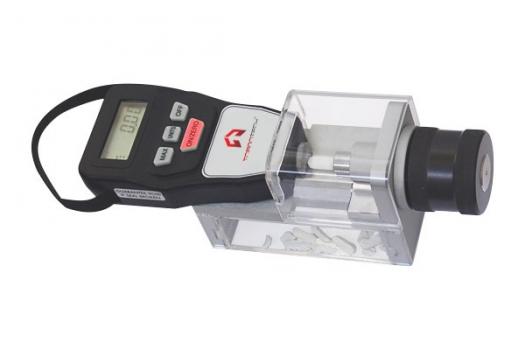As Human Metapneumovirus (HMPV) cases continue to rise, researchers are focusing on developing accurate and efficient diagnostic tools to meet the growing demand. The emphasis on advancing HMPV testing protocols ensures progress toward effective diagnostic solutions that support better outcomes for patients and contribute to broader public health efforts.
This article provides a comprehensive guide to HMPV testing, from the latest diagnostic research to overcoming common challenges. By exploring this information, researchers can gain valuable insights into implementing and improving testing processes, paving the way for enhanced respiratory care diagnostics in the future.
What is HMPV?

HMPV is a respiratory virus that affects people of all ages but poses the greatest risk to young children, older adults, and individuals with weakened immune systems. Discovered in 2001, HMPV is now recognized as a significant cause of respiratory illnesses worldwide, often mistaken for other common infections like RSV or influenza.
The virus typically spreads through respiratory droplets, direct contact, or contaminated surfaces. Common HMPV symptoms include fever, cough, shortness of breath, and fatigue. In severe cases, particularly in vulnerable populations, it can lead to complications such as HMPV pneumonia, which may require hospitalization.
As cases of HMPV infection rise globally, the need for awareness and accurate diagnosis becomes increasingly urgent. Research indicates that HMPV is often underdiagnosed due to overlapping symptoms with other respiratory viruses, making HMPV testing important for timely and effective care (Feng, He, Zhang, Yuan, & Zhou, 2024).
Why is HMPV Testing Important?
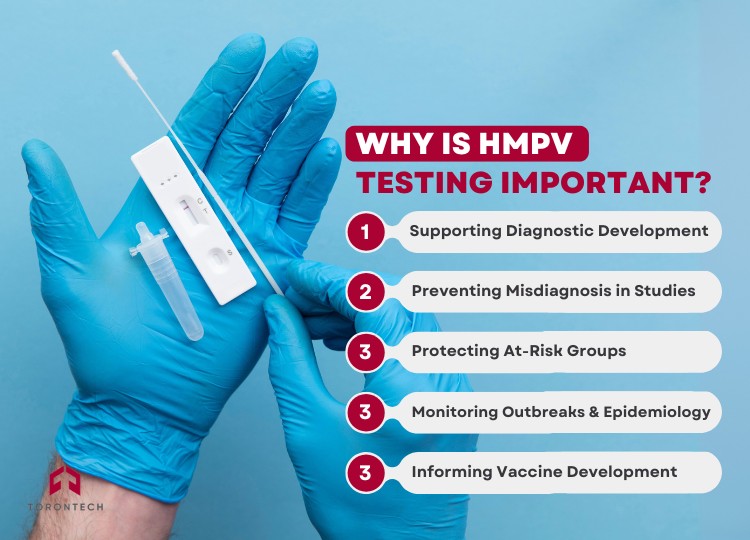
Accurate diagnosis is crucial when dealing with respiratory illnesses, particularly HMPV, which shares symptoms with RSV and influenza. Implementing effective HMPV testing protocols ensures precise diagnostics and improved patient outcomes.
1. Supporting Diagnostic Development
Research-driven HMPV testing aids in evaluating and improving current diagnostic tools, such as molecular diagnostics and rapid antigen tests. By identifying the strengths and limitations of existing methods, researchers can develop innovative solutions that enhance diagnostic accuracy and efficiency. For example, ongoing studies on the HMPV Rapid Test have highlighted its potential for quick and reliable detection.
2. Preventing Misdiagnosis in Studies
Misdiagnosis remains a significant challenge when researching HMPV due to its symptom overlap with other respiratory infections. Without accurate diagnostic tools, cases can be attributed incorrectly, skewing data and delaying the development of effective treatments. Implementing reliable HMPV testing methods, such as molecular diagnostics and rapid antigen tests, ensures the accurate identification of the virus, enhancing the validity of research findings.
3. Protecting At-Risk Groups
Research into HMPV diagnostic tools focuses on early detection, particularly for at-risk groups such as children, elderly individuals, and immunocompromised patients. These populations are more likely to experience severe outcomes, including complications like HMPV pneumonia. Advancing HMPV testing technologies allows researchers to study the disease’s impact on these groups and develop targeted strategies to mitigate risks. (The Silent Threat of Human Metapneumovirus, 2025).
4. Monitoring Outbreaks and Epidemiology
Accurate HMPV testing enables researchers to monitor the spread of the virus, identify outbreaks, and study its epidemiology. This information is essential for developing public health strategies, improving infection control, and understanding the virus’s impact on high-risk populations, including children, the elderly, and immunocompromised individuals.
5. Informing Vaccine Development
Vaccine development, such as the IVX-A12 vaccine, relies heavily on insights derived from HMPV testing. By studying infection patterns and immune responses, researchers can design vaccines that target the virus effectively and complement diagnostic efforts.
Diagnostic Methods for HMPV Testing
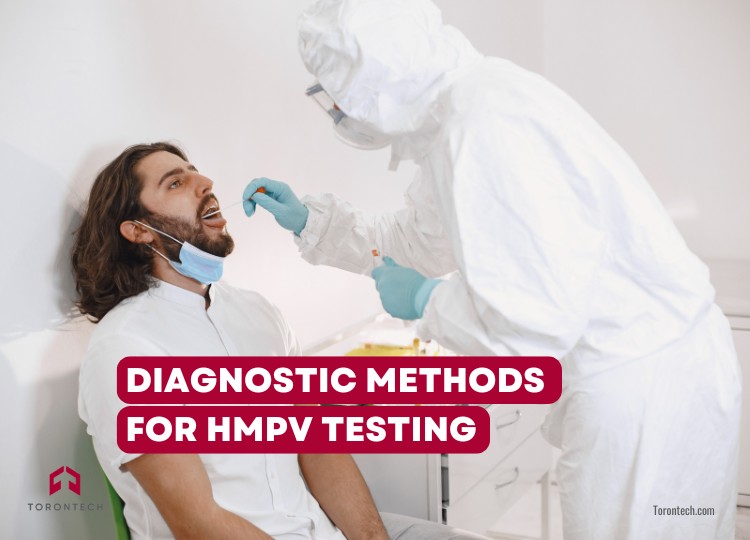
Accurate detection of HMPV virus is critical for research laboratories developing reliable diagnostic solutions. Rising global cases highlight the importance of advanced methods to support outbreak control and improve future patient care.
The HMPV Rapid Test, available for research use only, and molecular diagnostics offer researchers flexible, fast, and precise tools to refine testing protocols and address the challenges of HMPV detection effectively.
A. Standard Diagnostic Methods
- RT-PCR (Reverse Transcription Polymerase Chain Reaction):
Widely recognized as the gold standard for HMPV testing, RT-PCR offers unmatched sensitivity and specificity. By amplifying viral RNA, it detects even low viral loads, ensuring accurate diagnosis of HMPV infections (Feng et al., 2024). - RT-qPCR (Quantitative RT-PCR):
This variation of RT-PCR provides not only detection but also quantification of viral load, offering additional insights into the severity and progression of the infection. - LAMP (Loop-Mediated Isothermal Amplification):
A cost-effective and rapid alternative to PCR, LAMP is ideal for resource-limited settings or point-of-care applications. Its ease of use makes it a reliable tool for quick HMPV diagnostics (Feng et al., 2024).
B. Sample Collection Techniques
- Nasal Swabs: Preferred for their ease of use and high yield of viral material.
- Throat Swabs: An alternative method when nasal sampling is not feasible.
C. Rapid Antigen Testing for HMPV Virus – Recommendation Device
Rapid antigen tests have gained significant attention for their ability to deliver results within minutes, especially in urgent care settings. A study published in the Journal of Clinical Microbiology (2009) evaluated the effectiveness of a rapid antigen test for HMPV using immunochromatography.
Currently, HMPV antigen testing such as HMPV Test Kit remains under active research and are available for research use only. These tests are designed to detect HMPV antigens in nasopharyngeal swab specimens using advanced immunochromatographic technology.
- Fast Results in 15 Minutes: Enables healthcare providers to make quick and informed decisions.
- Easy Visual Interpretation: Results are straightforward, reducing reliance on complex equipment or specialized training.
- High Accuracy: With sensitivity at 91.7%, specificity at 99.1%, and overall accuracy of 96.5%, it delivers dependable diagnostic performance.
- CE Certification: Assures quality and compliance with international standards.
Packaged in a user-friendly cassette format, these kits provide a practical and efficient solution for research facilities investigating diagnostic tools for Human Metapneumovirus (HMPV). Continued advancements aim to expand the accessibility and application of these rapid tests in broader clinical settings.
D. Choosing the Right Method
Molecular diagnostics, such as RT-PCR, remain the gold standard for accurate HMPV detection, but the HMPV Rapid Test, available for research use only, offers a practical solution for time-sensitive diagnostic studies. Its speed and ease of use make it particularly valuable in exploring urgent testing scenarios, as highlighted by findings in the Journal of Clinical Microbiology (2009).
Combining the rapid results of antigen tests with the precision of molecular methods enables researchers to develop comprehensive and effective diagnostic protocols for addressing the challenges of HMPV detection.
Challenges in HMPV Testing
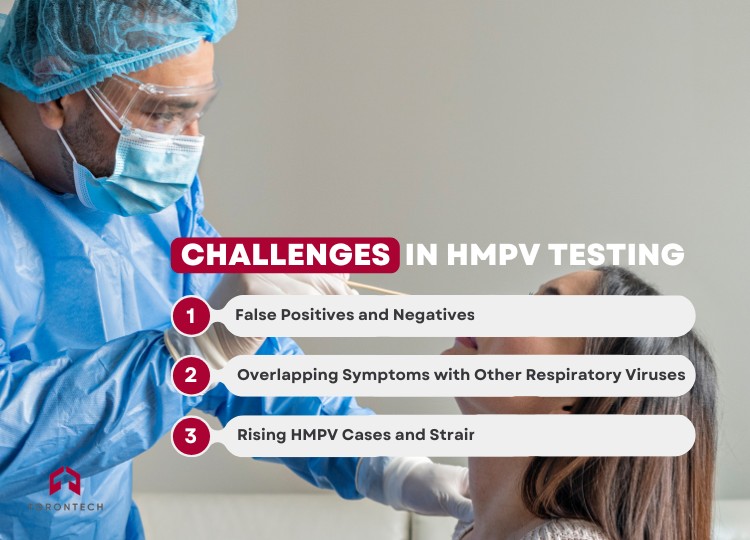
The global rise of Human Metapneumovirus presents significant challenges for research laboratories in developing timely and accurate diagnostic solutions. Overcoming these obstacles is essential to advancing diagnostics, supporting outbreak control, and contributing to broader public health efforts.
1. False Positives and Negatives
One of the major hurdles in HMPV testing is the potential for false results, especially with rapid antigen tests. While tests like the HMPV Rapid Test offer high accuracy (96.5%), certain conditions—such as early or late stages of infection—can affect test sensitivity (Evaluation of a New Rapid Antigen Test, 2009).
Molecular diagnostics like RT-PCR minimize these risks but may require more resources and technical expertise.
2. Overlapping Symptoms with Other Respiratory Viruses
HMPV symptoms, including fever, cough, and respiratory distress, often mimic those of RSV, influenza, and other respiratory viruses. This overlap can lead to misdiagnosis if appropriate diagnostic tools are not utilized.
Rapid antigen tests like the HMPV Rapid Test help reduce this risk by providing quick differentiation, but molecular methods are often needed for confirmation (MDPI Microorganisms, 2025).
3. Rising HMPV Cases and Strain on Resources
The increasing prevalence of HMPV infections, especially in vulnerable populations like children and the elderly, has placed additional strain on diagnostic resources. Laboratories and hospitals must adapt to handle higher testing volumes while maintaining accuracy and efficiency (MDPI Microorganisms, 2025).
Final Thoughts
As HMPV virus cases continue to rise, the need for accurate and efficient diagnostics remains critical. The HMPV Rapid Test offers a fast and reliable solution, delivering results in just 15 minutes with high accuracy. Designed for nasopharyngeal swab specimens and meeting CE certification standards, this test demonstrates exceptional performance while simplifying workflows and ensuring timely results.
Currently available for research use only, the HMPV Rapid Test serves as an invaluable tool for laboratories and researchers investigating diagnostic methods for HMPV. Its ease of use, precision, and portability make it a key resource for advancing research on respiratory infections and preparing for future clinical applications.
By leveraging trusted solutions like the HMPV Rapid Test, research teams can contribute to the development of effective diagnostic tools and support public health efforts.
References:
- Feng, Y., He, T., Zhang, B., Yuan, H., & Zhou, Y. (2024). Epidemiology and diagnosis technologies of human metapneumovirus in China: A mini review. Virology Journal.
- The Silent Threat of Human Metapneumovirus: Clinical Challenges and Therapeutic Opportunities. (2025). MDPI Microorganisms.
- Evaluation of a New Rapid Antigen Test Using Immunochromatography for Detection of Human Metapneumovirus. (2009). Journal of Clinical Microbiology.

